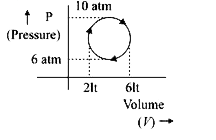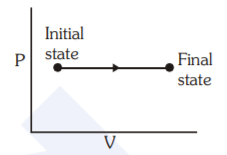An ideal gas is undergoing a cyclic thermodynamic process in different ways as shown in the corresponding P-V diagrams in column 3 of the table. Consider only the path from state 1 to state 2. W denotes the corresponding work done on the system. The equations and plots in the table have standard notations as used in thermodynamic process. Here is the ratio of heat capacities at constant pressure and constant volume. The number of moles in the gas in n.


Which of the following options is the only correct representation of a process in which ΔU=ΔQ−PΔV?
(IV) (ii) (S)
(III) (ii) (S)
(II) (iv) (R)
(II) (iv) (P)
The correct Answer is:B
(A) In correct since in Isochoric process W=0
(B) Correct as Wisochoric=0
Graph is also correct.
(C) Not correct combinations since W1→2=−PV2+PV1 is wrong for Adiabatic process.
(D) Incorrect combination of graph and process.
Similar Questions
In the graph shown below A-B, B-C , C-D are parts of the carnot cycle operating on an ideal gas.Consider only the path from State 1 to State 2 . W denotes the work in the path. Equations and plots in the table have standard notations γ is the ratio of heat capacities at constant pressure and constant volume. The moles of the gas is 'n'.

For which of the following options dQrev(sys)T>0 and simultaneously dQirrev(sys)T>0 If taken irreversiblyView SolutionAn ideal gas system undergoes an isothermal process, then the work done during the process is
View Solution
Knowledge Check
- Question 1 - Select One
An ideal gas is undergoing a cyclic thermodynamic process in different ways as shown in the corresponding P-V diagrams in column 3 of the table. Consider only the path from state 1 to state 2. W denotes the corresponding work done on the system. The equations and plots in the table have standard notations as used in thermodynamic process. Here is the ratio of heat capacities at constant pressure and constant volume. The number of moles in the gas in n.


Which of the following options is the only correct representation of a process in which ΔU=ΔQ−PΔV?A(IV) (ii) (S)B(III) (ii) (S)C(II) (iv) (R)D(II) (iv) (P) - Question 2 - Select One
In the graph shown below A-B, B-C , C-D are parts of the carnot cycle operating on an ideal gas.Consider only the path from State 1 to State 2 . W denotes the work in the path. Equations and plots in the table have standard notations γ is the ratio of heat capacities at constant pressure and constant volume. The moles of the gas is 'n'.

For which of the following options dQirrev(sys)T>dQrev(sys)TA(I)(iv)(Q)B(IV)(i)(P)C(II)(iii)(R)DNone of these - Question 3 - Select One
In the graph shown below A-B, B-C , C-D are parts of the carnot cycle operating on an ideal gas.Consider only the path from State 1 to State 2 . W denotes the work in the path. Equations and plots in the table have standard notations γ is the ratio of heat capacities at constant pressure and constant volume. The moles of the gas is 'n'.

For which of the following options dQrevsysT=0 and dQrev(sys)T=0 it taken irreversiblyA(I)(iv)(Q)B(IV)(i)(P)C(II)(iii)(R)DNone of these
An ideal gas system undergoes an isothermal process, then the work done during the process is
View SolutionThe thermodynamic process in which no work is done on or by the gas is
View SolutionThe thermodynamic process in which no work is done on or by the gas is
View SolutionAn ideal gas undergoes a cyclic process whose indicator diagram is as shown in the figure. Find the work done by the gas in 1 complete cycle.
 View Solution
View SolutionPV Diagram for ideal gas in piston cylinder assembly undergoing a thermodynamic process is shown in figure. Process is
 View Solution
View Solution

